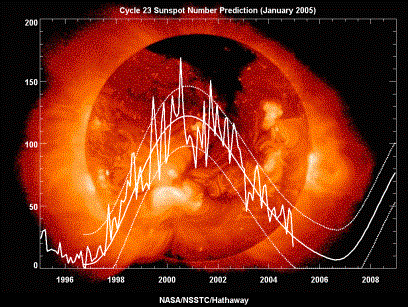Oops, Sun does heat the earth! - Duke U

It seems the current "Global Warming" model, which I assume is not the same as a "Climate Change" model, didn't include inconvenient accurate data that the sun's increased output would affect the earth. (A subtle concept) Duke, building on a Columbia analysis improves prior "flawed" analysis.
On the right - sunspots are predictive regarding solar storms. I hear this means we are in for a global cooling for a few years. See graph.
Sun's Direct Role in Global Warming May Be Underestimated, Duke Physicists Report
Study does not discount the suspected contributions of 'greenhouse gases' in elevating surface temperatures
Durham, N.C. -- At least 10 to 30 percent of global warming measured during the past two decades may be due to increased solar output rather than factors such as increased heat-absorbing carbon dioxide gas released by various human activities, two Duke University physicists report...[edited out para on this doesn't kill off the man is evil theory.]
Scafetta's and West's study follows a Columbia University researcher's report of previous errors in the interpretation of data on solar brightnesscollected by sun-observing satellites.
The Duke physicists also introduce new statistical methods that they assert more accurately describe the atmosphere's delayed response to solar heating. In addition, these new methods filter out temperature-changing effects not tied to global warming, they write in their paper.
According to Scafetta, records of sunspot activity suggest that solar output has been rising slightly for about 100 years. However, only measurements of what is known as total solar irradiance gathered by satellites orbiting since 1978 are considered scientifically reliable, he said.
But observations over those years were flawed by the space shuttle Challenger disaster, which prevented the launching of a new solar output detecting satellite called ACRIM 2 to replace a previous one called ACRIM 1.
That resulted in a two-year data gap that scientists had to rely on other satellites to try to bridge. "But those data were not as precise as those from ACRIM 1 and ACRIM 2,” Scafetta said in an interview.
Nevertheless, several research groups used the combined satellite data to conclude that that there was no increased heating from the Sun to contribute to the global surface warming observed between 1980 and 2002, the authors wrote in their paper.
Lacking a standardized, uninterrupted data stream measuring any rising solar influence, those groups thus surmised that all global temperature increases measured during those years had to be caused by solar heat-trapping "greenhouse" gases such as carbon dioxide, introduced into Earth's atmosphere by human activities, their paper added.
But a 2003 study by a group headed by Columbia's Richard Willson, principal investigator of the ACRIM experiments, challenged the previous satellite interpretations of solar output. Willson and his colleagues concluded, rather that their analysis revealed a significant upward trend in average solar luminosity during the period.
Using the Columbia findings as the starting point for their study, Scafetta and West then statistically analyzed how Earth's atmosphere would respond to slightly stronger solar heating. Importantly, they used an analytical method that could detect the subtle, complex relationships between solar output and terrestrial temperature patterns.
The Duke analyses examined solar changes over a period twice as long -- 22 versus 11years -- as was previously covered by another group employinga different statistical approach.
"The problem is that Earth's atmosphere is not in thermodynamic equilibrium with the sun," Scafetta said. "The longer the time period the stronger the effect will be on the atmosphere, because it takes time to adapt."
Using a longer 22 year interval also allowed the Duke physicists to filter out shorter range effects that can influence surface temperatures but are not related to global warming, their paper said. Examples include volcanic eruptions, which can temporarily cool the climate, and ocean current changes such as el Nino that affect global weather patterns.
Applying their analytical method to the solar output estimates by the Columbia group, Scafetta's and West's paper concludes that "the sun may have minimally contributed about 10 to 30 percent of the 1980-2002 global surface warming."
This study does not discount that human-linked greenhouse gases contribute to global warming, they stressed. "Those gases would still give a contribution, but not so strong as was thought," Scafetta said.
"We don't know what the Sun will do in the future," Scafetta added. "For now, if our analysis is correct, I think it is important to correct the climate models so that they include reliable sensitivity to solar activity.
"Once that is done, then it will be possible to better understand what has happened during the past hundred years."For more information, contact: Monte Basgall | (919) 681-8057 | monte.basgall@duke.edu
Labels: Global warming

0 Comments:
Post a Comment
Subscribe to Post Comments [Atom]
<< Home